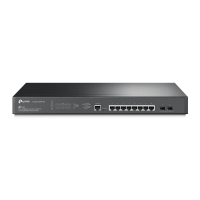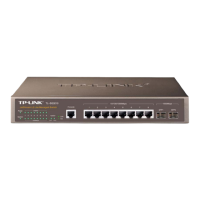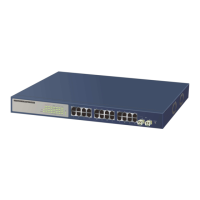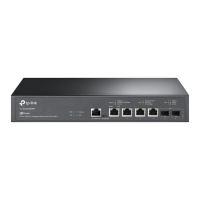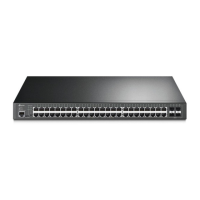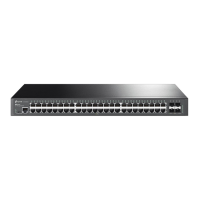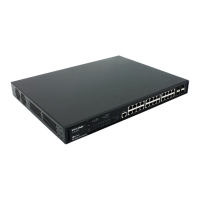Do you have a question about the TP-Link TL-SG3210 and is the answer not in the manual?
Compliance statement regarding FCC regulations for digital devices.
Warning regarding the product's classification as a Class A digital device.
Identifies the target audience for this user guide.
Explains the conventions and symbols used in the guide.
Provides a brief overview of the guide's chapter structure.
General description of the switch's design and capabilities.
Highlights key features like resiliency, Layer 2 switching, quality of service, and security.
Details the physical layout of the switch's front and rear panels.
Steps to access the switch's configuration utility via a web browser.
Overview of configuring the switch through the main setup menu.
Details on viewing and configuring system properties like summary, time, and IP settings.
Manages user accounts and access levels for the web management interface.
Provides tools for managing configuration files, firmware, and system state.
Configures security measures for remote login and access control.
Configuration of basic port parameters, including speed, duplex, and status.
Configuration of Link Aggregation Group for increased bandwidth and reliability.
Tools for monitoring traffic flow on each port.
Management of MAC address tables, including static and dynamic entries.
Configuration of 802.1Q VLANs using VLAN tags for packet identification.
Classification of VLANs based on MAC addresses for enhanced network segmentation.
Configuration of VLANs based on network protocols for specific traffic management.
Demonstrates practical application of 802.1Q VLAN configuration.
Global configuration of STP parameters, including priority and timers.
Configuration of STP parameters for individual ports.
Configuration of Multiple Spanning Tree Protocol instances for complex network topologies.
Security features to protect STP from attacks like BPDU Guard and Root Guard.
Manages IP multicast group membership by snooping IGMP messages.
Manages IPv6 multicast group membership by snooping MLD messages.
Viewing IPv4 and IPv6 multicast group information.
Configuration of Differentiated Services Code Point for traffic classification and prioritization.
Tools for controlling traffic rate and broadcast flow on ports.
Configuration of Voice VLANs for prioritizing voice traffic.
Global and port-specific configuration of PoE power supply.
Scheduling PoE power supply based on time ranges and holidays.
Defining time ranges for ACLs to control access based on schedule.
Creating and configuring ACL rules for traffic matching and policy enforcement.
Defining policies that specify actions for traffic matching ACL rules.
Binding policies to ports or VLANs to apply access control rules.
Binding IP and MAC addresses to control network access and detect ARP spoofing.
Detecting and preventing ARP attacks like spoofing and flooding.
Defending against Denial of Service attacks by analyzing and filtering malicious packets.
Implementing port-based network access control for user authentication.
Global configuration of SNMP, including views, groups, users, and communities.
Configuring SNMP notifications (Traps and Informs) for network events.
Configuring Remote Monitoring capabilities for network traffic analysis.
Neighbor Discovery Protocol for gathering information about directly connected network devices.
Neighbor Topology Discovery Protocol for collecting topology information and managing clusters.
Configuration and management of cluster settings, roles, and summaries.
Practical example demonstrating cluster configuration and operation.
Global and port configuration for LLDP parameters.
Viewing LLDP information for local devices and neighbors.
Viewing LLDP statistics for the local device.
Extension of LLDP for managing media endpoint devices like VoIP phones.
Monitoring CPU and memory utilization status of the switch.
Managing system logs, including viewing tables and configuring remote logging.
Performing cable tests and other device diagnostics.
Testing network connectivity using Ping and Tracert.
Compliance statement regarding FCC regulations for digital devices.
Warning regarding the product's classification as a Class A digital device.
Identifies the target audience for this user guide.
Explains the conventions and symbols used in the guide.
Provides a brief overview of the guide's chapter structure.
General description of the switch's design and capabilities.
Highlights key features like resiliency, Layer 2 switching, quality of service, and security.
Details the physical layout of the switch's front and rear panels.
Steps to access the switch's configuration utility via a web browser.
Overview of configuring the switch through the main setup menu.
Details on viewing and configuring system properties like summary, time, and IP settings.
Manages user accounts and access levels for the web management interface.
Provides tools for managing configuration files, firmware, and system state.
Configures security measures for remote login and access control.
Configuration of basic port parameters, including speed, duplex, and status.
Configuration of Link Aggregation Group for increased bandwidth and reliability.
Tools for monitoring traffic flow on each port.
Management of MAC address tables, including static and dynamic entries.
Configuration of 802.1Q VLANs using VLAN tags for packet identification.
Classification of VLANs based on MAC addresses for enhanced network segmentation.
Configuration of VLANs based on network protocols for specific traffic management.
Demonstrates practical application of 802.1Q VLAN configuration.
Global configuration of STP parameters, including priority and timers.
Configuration of STP parameters for individual ports.
Configuration of Multiple Spanning Tree Protocol instances for complex network topologies.
Security features to protect STP from attacks like BPDU Guard and Root Guard.
Manages IP multicast group membership by snooping IGMP messages.
Manages IPv6 multicast group membership by snooping MLD messages.
Viewing IPv4 and IPv6 multicast group information.
Configuration of Differentiated Services Code Point for traffic classification and prioritization.
Tools for controlling traffic rate and broadcast flow on ports.
Configuration of Voice VLANs for prioritizing voice traffic.
Global and port-specific configuration of PoE power supply.
Scheduling PoE power supply based on time ranges and holidays.
Defining time ranges for ACLs to control access based on schedule.
Creating and configuring ACL rules for traffic matching and policy enforcement.
Defining policies that specify actions for traffic matching ACL rules.
Binding policies to ports or VLANs to apply access control rules.
Binding IP and MAC addresses to control network access and detect ARP spoofing.
Detecting and preventing ARP attacks like spoofing and flooding.
Defending against Denial of Service attacks by analyzing and filtering malicious packets.
Implementing port-based network access control for user authentication.
Global configuration of SNMP, including views, groups, users, and communities.
Configuring SNMP notifications (Traps and Informs) for network events.
Configuring Remote Monitoring capabilities for network traffic analysis.
Neighbor Discovery Protocol for gathering information about directly connected network devices.
Neighbor Topology Discovery Protocol for collecting topology information and managing clusters.
Configuration and management of cluster settings, roles, and summaries.
Practical example demonstrating cluster configuration and operation.
Global and port configuration for LLDP parameters.
Viewing LLDP information for local devices and neighbors.
Viewing LLDP statistics for the local device.
Extension of LLDP for managing media endpoint devices like VoIP phones.
Monitoring CPU and memory utilization status of the switch.
Managing system logs, including viewing tables and configuring remote logging.
Performing cable tests and other device diagnostics.
Testing network connectivity using Ping and Tracert.
| Switching Capacity | 20 Gbps |
|---|---|
| Forwarding Rate | 14.88 Mpps |
| Fan Quantity | Fanless |
| Power Supply | 100-240V AC, 50/60Hz |
| MAC Address Table | 8K |
| Jumbo Frame | 9 KB |
| Mounting | Rack Mountable |
| Operating Humidity | 10% to 90% non-condensing |
| Storage Humidity | 5% to 90% non-condensing |
| Ports | 8 Gigabit RJ45 Ports, 2 Gigabit SFP Slots |
| VLAN | 802.1Q VLAN, Port-based VLAN |
| QoS | 8 priority queues, 802.1p CoS/DSCP priority |
| Management | Web-based GUI, Command Line Interface, SNMP, RMON, Dual Image |
| Dimensions | 440 x 180 x 44mm (17.32 x 7.09 x 1.73in) |
| Standards and Protocols | IEEE 802.3i, IEEE 802.3u, IEEE 802.3ab, IEEE 802.3z, IEEE 802.3x, IEEE 802.1Q, IEEE 802.1p, IEEE 802.1d, IEEE 802.1s, IEEE 802.1w, IEEE 802.3ad |
| Operating Temperature | 0°C |
| Storage Temperature | -40°C to 70°C (-40°F to 158°F) |
